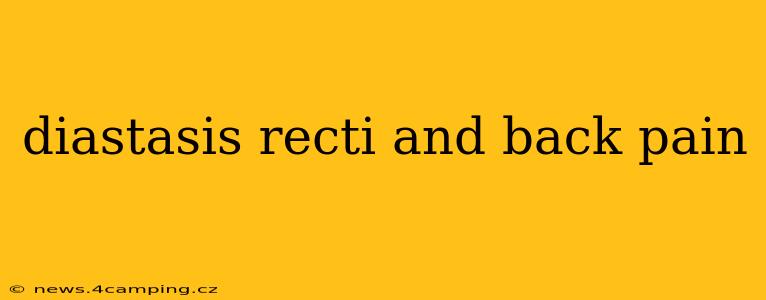Diastasis recti, the separation of the abdominal muscles, often gets associated with postpartum recovery. However, it can also contribute to back pain, regardless of whether you've given birth. This article delves into the connection between diastasis recti and back pain, exploring its causes, symptoms, and management strategies. We'll answer common questions surrounding this often-overlooked condition.
What is Diastasis Recti?
Diastasis recti is the widening of the linea alba, the connective tissue that runs down the middle of your abdomen, separating your rectus abdominis muscles (the "six-pack" muscles). This separation can range from a subtle widening to a significant gap, and it's not always visually apparent. While pregnancy and childbirth significantly increase the risk, diastasis recti can affect individuals of any age and gender, often stemming from activities involving repetitive abdominal straining.
How Does Diastasis Recti Cause Back Pain?
The connection between diastasis recti and back pain isn't always direct but rather stems from the compromised core stability it creates. A weakened abdominal wall leads to:
- Increased lumbar lordosis: Your lower back curves excessively to compensate for the lack of abdominal support, placing undue stress on your spine. This increased curvature is a primary culprit behind diastasis recti-related back pain.
- Poor posture: The weakened core muscles impact your posture, forcing you to rely on other muscles to maintain balance. This often leads to rounded shoulders, forward head posture, and overall poor alignment, contributing to back pain.
- Muscle imbalances: To compensate for the weakened abdominal muscles, other muscles, like those in the lower back, may overwork, leading to tension, spasms, and pain.
- Increased pressure on the spine: The lack of proper abdominal support increases pressure on the spine, potentially exacerbating existing back conditions or causing new ones.
Can Diastasis Recti Cause Lower Back Pain?
Yes, diastasis recti can absolutely contribute to lower back pain. As explained above, the instability in the core caused by the separated abdominal muscles forces the lower back to work harder, ultimately leading to pain. This pain can range from mild discomfort to severe, debilitating aches.
How is Diastasis Recti Diagnosed?
Diagnosing diastasis recti involves a physical examination. Your healthcare professional will assess the width of the gap between your abdominal muscles by feeling your abdomen while performing certain movements. Imaging techniques like ultrasound might be used in some cases, particularly if the diagnosis is unclear.
What are the Treatments for Diastasis Recti and Associated Back Pain?
Treatment for diastasis recti and associated back pain focuses on improving core strength and stability. This typically involves:
- Physical therapy: A physical therapist can design a specialized exercise program to safely strengthen your core muscles and improve posture. This program will likely focus on exercises that do not increase abdominal pressure.
- Postural correction: Improving your posture through conscious effort and specific exercises is vital in reducing strain on your back.
- Manual therapy: Techniques like osteopathic manipulation may be beneficial in alleviating muscle tension and improving joint mobility.
- Targeted exercises: Specific exercises designed to close the gap and strengthen the abdominal muscles are crucial, but it's essential to perform these under the guidance of a healthcare professional to avoid further injury.
What Exercises Should I Avoid with Diastasis Recti?
It's crucial to avoid exercises that increase intra-abdominal pressure, which can worsen the separation. These include:
- Traditional crunches: These put significant strain on the abdominal muscles and linea alba.
- Planks (unless modified): Standard planks can exacerbate diastasis recti if performed incorrectly. Modified planks focusing on proper core engagement are usually preferred.
- Situps: Similar to crunches, sit-ups exert too much pressure on the abdominal wall.
- Heavy weightlifting: Lifting heavy weights, especially when engaging the abdominal muscles, can worsen the condition.
When Should I See a Doctor About Diastasis Recti and Back Pain?
You should consult a doctor if you experience persistent lower back pain along with symptoms suggestive of diastasis recti, such as a visible or palpable bulge in your abdomen. Early intervention is key to managing this condition effectively and preventing long-term complications.
This information is for general knowledge and doesn't constitute medical advice. Always consult a healthcare professional for diagnosis and treatment of any medical condition.
